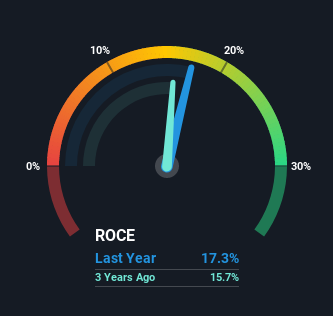
There are a few key trends to look for if we want to identify the next multi-bagger. Typically, we'll want to notice a trend of growing return on capital employed (ROCE) and alongside that, an expanding base of capital employed. Ultimately, this demonstrates that it's a business that is reinvesting profits at increasing rates of return. Speaking of which, we noticed some great changes in Bilia's (STO:BILI A) returns on capital, so let's have a look.
Return On Capital Employed (ROCE): What is it?
For those that aren't sure what ROCE is, it measures the amount of pre-tax profits a company can generate from the capital employed in its business. The formula for this calculation on Bilia is:
Return on Capital Employed = Earnings Before Interest and Tax (EBIT) ÷ (Total Assets - Current Liabilities)
0.17 = kr2.1b ÷ (kr17b - kr5.3b) (Based on the trailing twelve months to September 2021).
Therefore, Bilia has an ROCE of 17%. In absolute terms, that's a satisfactory return, but compared to the Specialty Retail industry average of 13% it's much better.
Check out our latest analysis for Bilia

Historical performance is a great place to start when researching a stock so above you can see the gauge for Bilia's ROCE against it's prior returns. If you'd like to look at how Bilia has performed in the past in other metrics, you can view this free graph of past earnings, revenue and cash flow.
What Can We Tell From Bilia's ROCE Trend?
The trends we've noticed at Bilia are quite reassuring. The numbers show that in the last five years, the returns generated on capital employed have grown considerably to 17%. The amount of capital employed has increased too, by 134%. So we're very much inspired by what we're seeing at Bilia thanks to its ability to profitably reinvest capital.
In another part of our analysis, we noticed that the company's ratio of current liabilities to total assets decreased to 31%, which broadly means the business is relying less on its suppliers or short-term creditors to fund its operations. This tells us that Bilia has grown its returns without a reliance on increasing their current liabilities, which we're very happy with.
What We Can Learn From Bilia's ROCE
A company that is growing its returns on capital and can consistently reinvest in itself is a highly sought after trait, and that's what Bilia has. Since the stock has returned a solid 60% to shareholders over the last five years, it's fair to say investors are beginning to recognize these changes. With that being said, we still think the promising fundamentals mean the company deserves some further due diligence.
Bilia does have some risks, we noticed 2 warning signs (and 1 which is significant) we think you should know about.
For those who like to invest in solid companies, check out this free list of companies with solid balance sheets and high returns on equity.
If you're looking to trade Bilia, open an account with the lowest-cost platform trusted by professionals, Interactive Brokers.
With clients in over 200 countries and territories, and access to 160 markets, IBKR lets you trade stocks, options, futures, forex, bonds and funds from a single integrated account.
Enjoy no hidden fees, no account minimums, and FX conversion rates as low as 0.03%, far better than what most brokers offer.
Sponsored ContentValuation is complex, but we're here to simplify it.
Discover if Bilia might be undervalued or overvalued with our detailed analysis, featuring fair value estimates, potential risks, dividends, insider trades, and its financial condition.
Access Free AnalysisHave feedback on this article? Concerned about the content? Get in touch with us directly. Alternatively, email editorial-team (at) simplywallst.com.
This article by Simply Wall St is general in nature. We provide commentary based on historical data and analyst forecasts only using an unbiased methodology and our articles are not intended to be financial advice. It does not constitute a recommendation to buy or sell any stock, and does not take account of your objectives, or your financial situation. We aim to bring you long-term focused analysis driven by fundamental data. Note that our analysis may not factor in the latest price-sensitive company announcements or qualitative material. Simply Wall St has no position in any stocks mentioned.
About OM:BILI A
Bilia
Operates as a full-service supplier for car ownership in Sweden, Norway, Luxemburg, and Belgium.
Undervalued with adequate balance sheet and pays a dividend.
Market Insights
Community Narratives



